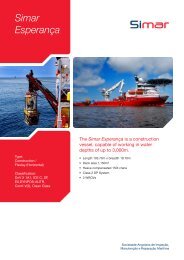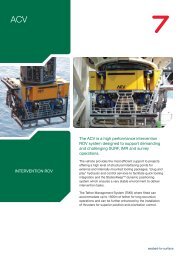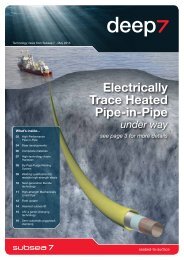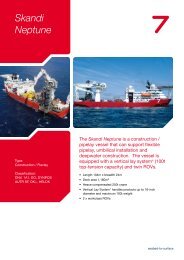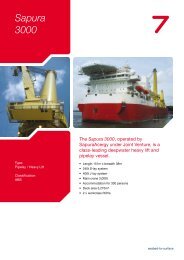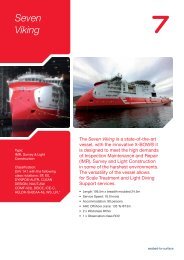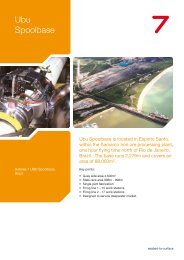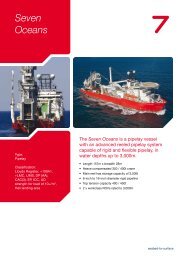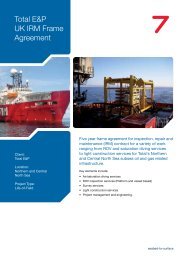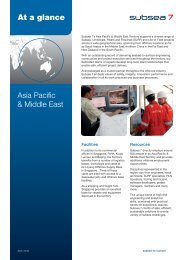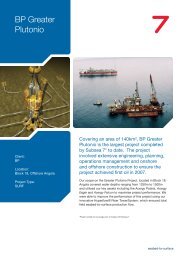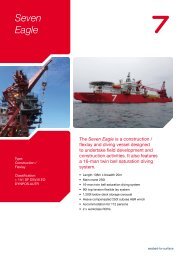World-class welding technologies - Subsea 7
World-class welding technologies - Subsea 7
World-class welding technologies - Subsea 7
Create successful ePaper yourself
Turn your PDF publications into a flip-book with our unique Google optimized e-Paper software.
Planning and precision<br />
combine on Pazflor<br />
The successful installation by<br />
<strong>Subsea</strong> 7 of three subsea separation<br />
units (SSUs), operated by Total E&P<br />
Angola, proved critical to the early<br />
completion of the landmark Pazflor<br />
project on Block 17, offshore Angola.<br />
The challenging project involved the<br />
world’s first deployment of vertical<br />
SSUs to separate the oil, gas and<br />
water produced from Pazflor’s<br />
Miocene reservoirs.<br />
Installing each SSU (weighing in excess<br />
of 1,000t, including suction anchors)<br />
required an unprecedented level of<br />
precision in water depths around 800m<br />
and a close working relationship with<br />
Total and the SSU manufacturer, FMC,<br />
to ensure the final design included<br />
offshore installation requirements.<br />
Operational requirements necessitated<br />
exceptionally tight installation<br />
tolerances of +/- 0.5° from horizontal<br />
when installing the cluster of four<br />
suction anchor foundations. To achieve<br />
this target, <strong>Subsea</strong> 7 developed the<br />
lifting arrangement, and interfaced with<br />
FMC to accurately operate the levelling<br />
system based on differential suction.<br />
Early analyses showed a risk of<br />
resonance of the subsea hardware<br />
during lowering, potentially leading<br />
to significant weather sensitivity. To<br />
mitigate this issue, <strong>Subsea</strong> 7 developed<br />
a real-time monitoring system receiving<br />
acceleration data from sensors located<br />
on the crane tip and on top of the<br />
hardware as they were lowered.<br />
Extensive dry and shallow water testing<br />
in Norway allowed the team to test<br />
the SSU installation before the units<br />
were finally transported to Angola.<br />
Working in close liaison with FMC,<br />
<strong>Subsea</strong> 7 coordinated transportation<br />
and designed a specific sea fastening<br />
to minimise fatigue of the SSUs. Prior<br />
to deployment on site by <strong>Subsea</strong> 7’s<br />
installation vessel the Acergy Polaris,<br />
the structure’s integrity was re-tested in<br />
Luanda bay.<br />
Connecting each SSU to the subsea<br />
manifold was a complex and delicate<br />
operation in which the ROV operators<br />
had to first remove caps from the<br />
SSU shallow water tests in Norway<br />
manifold followed by the operation of<br />
a jacking system to slide the 400t, sixstorey<br />
high SSU towards the manifold to<br />
mate three connections simultaneously.<br />
The Seven Eagle performed the SSU<br />
umbilical installation and the tie-in of the<br />
first pair of four multi-phase pumps.<br />
The landmark project, in which first<br />
oil was achieved ahead of schedule<br />
including the development and<br />
installation of new technology,<br />
underlines the importance of effective<br />
interfaces between suppliers,<br />
contractors and client.<br />
<strong>Subsea</strong> 7 continues to develop new<br />
deployment systems including fibrerope<br />
and active-heave compensation<br />
that are deemed essential in the<br />
deployment and retrieval of sensitive<br />
rotating machinery and processing<br />
systems in ever-increasing water depths<br />
of the future.<br />
A Pazflor SSU being installed<br />
05<br />
seabed-to-surface



